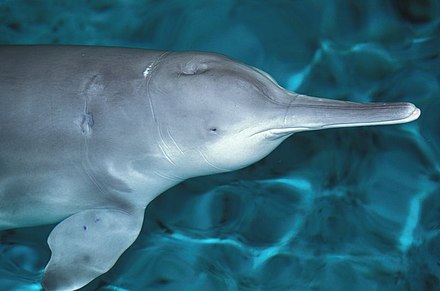Dolphins and dolphin products are in use for medical purpose in many countries across the Indian ocean. Stories about this animal were gathered and written by students. They are all part of a pedagogical project, funded by the National University of Singapore and the Université de Paris. The Bestiary site is a work-in-progress and a participatory educational tool, representing animals whose products or body parts are used to promote health and healing.
To Dip in the River
A story by Prasha Maithani
The baiji (Lipotes vexillifer) is a fresh-water dolphin found in the Yangtze river in China. It is most well-known as the poster species for the environmental damage that accompanied rapid economic development in the country. The baiji is also scientifically important because of its distinct features; it has been living in the Yangtze for 20 million years and is the only member of the mammal family Lipotidae. Once plentiful throughout the Yangtze, the baiji population has dwindled so drastically within fifty years, that it is now thought to be functionally extinct.
Threats from fishing (during the Great Leap Forward and as by-catch), the construction of the three gorges dam and excessive amounts of pollutants in the Yangtze took a toll on the baiji population. In 2006, researchers were unable to find a single individual during surveys and declared the baiji ‘functionally extinct’ (any existing populations would not be viable). While the IUCN status of the baiji is critically endangered, the website also mentions that they are possibly extinct, owing to the fact that since 2006, no conclusive evidence has been provided for the existence of the tragically gone baiji, the ‘Goddess’ of the Yangtze.
Like any animal living alongside humans in a habitat for long, the baiji has also gained cultural significance. According to Chinese folklore, the baiji is believed to be the reincarnation of a young maiden who jumped into the Yangtze river to escape her evil stepfather. After she jumped in, a dolphin was seen swimming in the river, and it was believed to be the girl. This dolphin, the baiji, came to be called the ‘Goddess of the Yangtze’ because of the courage of the young girl. Revered as a symbol of peace and prosperity, the ‘Goddess’ was also believed to provide protection to fishermen and boatmen who travelled along the Yangtze. The maiden’s stepfather was believed to have manifested as a finless porpoise, another marine mammal found in the Yangtze. Stemming from this folklore, the baiji came to be respected and was not actively hunted for consumption, whereas the finless porpoise was traditionally hunted and consumed due to its negative associations with the stepfather. Mass consumption of the baiji only began during the period of the Great Leap Forward, under chairman Mao Zedong, when people suffered from large-scale famine and starvation. The baiji is known to only have been consumed or used in traditional Chinese medicine (TCM) when individuals became stranded or when they were accidentally killed.
Dolphins and zoonoses
A recent study by Mathavarajah et al. (2020) highlighted the baiji as being at a high risk of infection by SARS-COV-2, the virus that caused the COVID-19 pandemic. The baiji’s low numbers, high levels of wastewater pollution in their habitat and the geography of their habitat (the Yangtze passes through Wuhan) were cited as the reasons that the baiji may possibly catch the virus. The chances of the baiji being infected, however, are incredibly low because of their extremely low numbers (possibly extinct) and the low probability of marine mammals being infected due to wastewater exposure (Larsen & Wigginton, 2020).
As the baiji has not been sighted for over a decade, there is scarce information and studies on zoonoses harboured by the baiji. Research done on the Delphinidae (oceanic, toothed dolphins), may be considered instead to understand the transfer of zoonoses. Dolphins (some colloquially called whales) are a charismatic megafauna that are often held captive in aquariums and amusement parks. This proximity to humans allows opportunities for the transfer of zoonoses from dolphins to humans, particularly to people who spend much more time with them like trainers, handlers, researchers, veterinarians, and fishermen (Hunt et al. 2008). Dolphins can get infected by a range of pathogens, including bacteria, viruses and fungi and pass on these pathogens to humans (Waltzek et al, 2012). Three instances of pathogens that are commonly passed on from dolphins to humans are listed below.
1 • Mycobacterium marinum, a bacterium, has been reported to be found in bottlenose dolphins and in a dolphin trainer who was bitten by a bottlenose. This bacteria spreads via contact with bodily secretions from the dolphin, such as its faeces or urine, exposure to contaminated environments, and also direct contact (biting). Dolphins may develop lesions in lungs and lymph nodes upon infection with this pathogen.
2 • Lacazia boi, a type of fungus that causes lobomycosis, has been reported in bottlenose and Guiana dolphins. Transmission to humans can occur through contact with infected individuals, as was observed in the case of an aquarium worker who contracted the pathogen upon occupational exposure to an infected bottlenose.
3 • Four rehabilitators and researchers working on the corpse of a beached pilot whale were later infected with Erysipelothrix rhusiopathiae, a bacterium that can cause sepsis and skin lesions in dolphins, and sepsis and dermatitis in humans.
Apart from these three cases, other pathogens that have been recorded as being transmissible from dolphins to humans are Brucella ceti (a bacterium) and Ajellomyces dermatitidis (a fungus).
Value in Asian medicine
Members of Delphinidae have also been known to be used in traditional medicine globally. Dolphins have been used in China, Cambodia, Philippines, and other regions of Asia to relieve ailments and illnesses, and to ward off evil spirits from ailing livestock and family. For instance, the common dolphin has been recorded in China to have medicinal uses, but the specific purpose of its usage is unclear (Porter & Lai, 2017). Other Delphinidae species that are known to be used in Asian societies are the killer whale and bottlenose dolphin. These species are also hunted for meat consumption, but the parts that are commonly extracted for medicinal purposes are body oil, pancreas and liver that are used for skin conditions, intestinal issues, and inflammation.
Qiqi, a Chinese River Dolphin © Roland Seitre, 30 October 2020, Institute of Hydrobiology, Chinese Academy of Sciences




